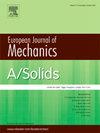The effect of temperature dependent elastic anisotropy on residual stresses and ratcheting in transpiration cooled Nickel gas turbine blades
IF 4.4
2区 工程技术
Q1 MECHANICS
引用次数: 0
Abstract
The conditions required for the ratcheting of a structure due to thermal and load cycling are typically calculated assuming a constant Young's modulus throughout the cycle. We show that this type of incremental collapse occurs at lower cyclic loads when the variation in Young's modulus with temperature is taken into account. This is because the increase of Young's modulus upon unloading from the high temperature operation state to the room temperature shutdown state enhances the residual stress field , and therefore the cyclic variation of stresses. In this respect, we find that Koiter's kinematic shakedown theorem still works as if the material has a room temperature yield stress that decreases as increases. This more broadly implies that conventional shakedown and low cycle fatigue analysis methods which have relied upon the fictitious elastic stress cannot be deemed credible for high temperature problems, since any location of a structure experiences an enhanced cyclic stress variation compatible with the enhancement of with Young's modulus. Our practical example is a double plate unit of a transpiration cooled single crystal Nickel gas turbine blade, whereby the two-fold increase of Young's modulus upon cooldown from to leads to compressive ratcheting at over 30% lower temperature differences than previously predicted. Our work informs the design of clean energy, transport and defence assets suffering severe thermal loads, including fusion/fission reactors, re-useable rockets, cryogenic hydrogen and transpiration cooling systems.
求助全文
约1分钟内获得全文
求助全文
来源期刊
CiteScore
7.00
自引率
7.30%
发文量
275
审稿时长
48 days
期刊介绍:
The European Journal of Mechanics endash; A/Solids continues to publish articles in English in all areas of Solid Mechanics from the physical and mathematical basis to materials engineering, technological applications and methods of modern computational mechanics, both pure and applied research.

 求助内容:
求助内容: 应助结果提醒方式:
应助结果提醒方式:


